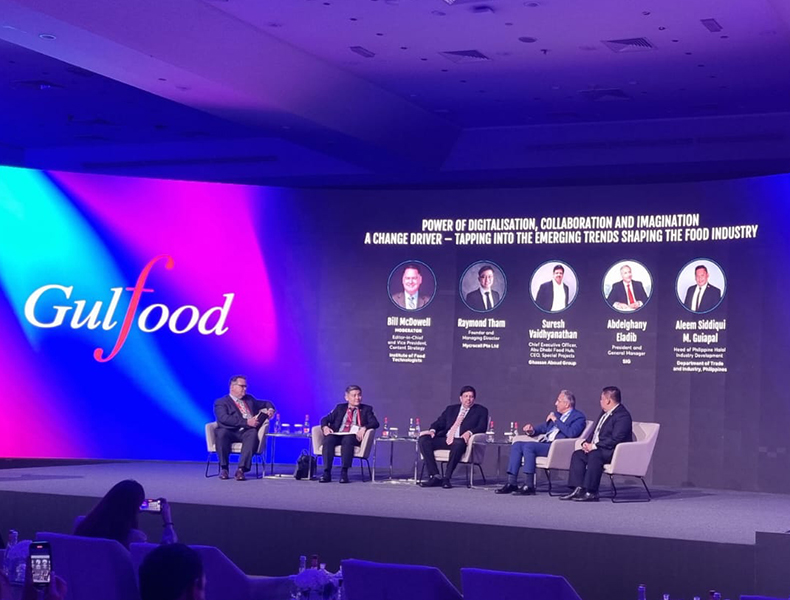Food Technology Magazine | Digital Exclusive
Gulfood conference highlights technology solutions to regional, global food problems
An overview of insights shared at the 2024 Gulfood Inspire conference in Dubai.

Bill McDowell, editor-in-chief, Food Technology magazine (far left), moderated a Gulfood Inspire conference panel discussion focused on digitalization, collaboration, and imagination with (from left) Raymond Tham, founder and managing director, Mycrocell; Suresh Vaidhyanathan, CEO, Abu Dhabi Food Hub and CEO, specialty projects, Ghassan Aboud Group; Abdelghany Eladib, president and general manager, SIG, IMEA; and Aleem Siddiqui M. Guiapal, head, Philippine Halal Industry Development, Philippines Department of Trade and Industry.
Leveraging technology to improve food system sustainability, reduce waste, fortify supply chain resilience, and anticipate changing consumer needs was a focus at the Gulfood Inspire conference now in progress in Dubai, a locale where 90% of food must be imported. The conference is taking place adjacent to a Gulfood event featuring 5,500 trade show exhibitors and an estimated 95,000 attendees from 190 countries.
Featuring a roster of more than 80 speakers and panelists representing a blend of industry leaders, academics, government officials, investors, and consultants, highlights from the conference program include the following:
Author and futurist Tom Cheesewright offered a keynote on how technology, culture, demographics, and lifestyle changes will influence consumer demand for food products over the next five years. He emphasized the significant role of the youth market in driving food trends, particularly in regions like Africa, where the average age is 25, in contrast to the older demographics of Europe and North America. Cheesewright also predicted the rise of small-scale, hyper-local fabrication and supply chains, which, despite potential inefficiencies, could offer benefits in terms of energy savings, land use optimization, waste reduction, and the ability to quickly meet consumer demand.
Consultant Tony Hunter stressed the necessity of leveraging technology to bridge the gap between current agricultural practices and the food requirements of a projected 10 billion people by 2050. He showcased emerging technologies such as alternative proteins, cellular agriculture, and synthetic biology as crucial for reducing dependence on arable land and fresh water. Hunter said innovation must not only aim to meet current needs but also leapfrog to future solutions, with a stark warning that food product developers not adopting generative AI risk falling irreversibly behind.
A panel discussion featuring entrepreneurs and regional industry leaders (see picture above) highlighted the importance of public-private partnerships in fostering food innovation, the urgent need to shift from traditional linear supply chains to more holistic global networks, the potential of processing side streams to reduce food waste, and a critical viewpoint on digital technology as a tool for facilitating better collaboration and information exchange rather than a standalone solution.
Amit Dutta of Frost & Sullivan presented an exclusive white paper detailing the transition from traditional supply chains to value-added supply networks, highlighting emerging food technologies and their role in the agrifood system. This transition, according to Dutta, presents significant market opportunities for those who adapt and innovate.
The conference also featured a panel on food security and sustainability, where speakers like Uzbekistan minister of agriculture and scientist Ibrokhim Abdurakhmonov discussed technological innovations for carbon sequestration and genetic engineering of crops for better carbon absorption. The panel also touched on the role of blockchain and satellite imagery in supporting regenerative farming practices.
Futurist Morgaine Gaye, in her Day 3 keynote, explored how consumer anxiety, post-Covid chaos, and global conflict are reshaping food product innovation. She pointed out the growing mistrust among consumers, especially Gen Z, and the opportunity for companies to embrace risk and uniqueness. Gaye forecasted a focus on primal needs, with a return to nature, the use of repurposed food waste, the rise of 3D printed edible packaging, and the importance of air and water in food production and presentation.ft




